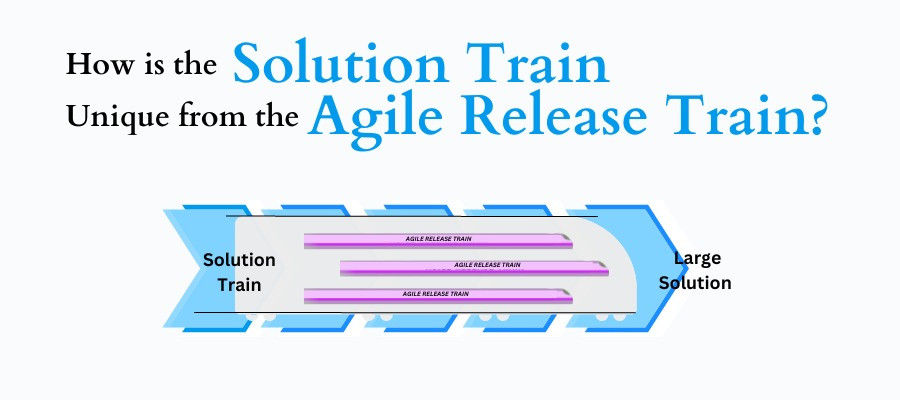How is the Solution Train Unique from the Agile Release Train?

The Solution Train is a modern Agile approach used to build complex Operational Solutions with the coordination of Agile Release Trains (ARTs) and Suppliers. Solution Train incorporates multiple ARTs into developing the ultimate solution vision and Product Roadmap. The Agile teams work collaboratively to develop an effective Solution Train based on the Product Vision.
If you are just starting your Agile Training, it’s essential to know the difference between a Solution Train and an Agile Release Train. This guide will thoroughly discuss everything you need to know to understand the Agile Methodologies & Release Components. So let’s begin!
Common Principles of Agile Release Trains & Solution Train:
Solution Train follows all principles of ARTs to operate. Here is the outline of common principles used by Solution Train and ARTs:
- Fixed Release Schedule: The solution plans and delivers work within a fixed schedule based on the Sprint.
- Sprint Schedule: Like Scrum, the Agile teams follow 2-week or 3-week Sprint Planning for the ARTs and Solution Train.
- Synchronization: All teams synchronize all work items in the same PI to operate on the same ART/Solution Train schedule.
- Agile Teams: High-performing Agile teams embrace the Agile Manifesto, such as Scrum and Kanban, to support ART/Solution Train.
- Work Estimation: Boat Solution train and ART can reliably estimate work deliverables with a single PI plan.
- Face-to-face PI Planning: Solution train and ARTs plan User Stories during the Agile Quarterly Program Increment (PI) Planning.
- Innovation and Planning (IP): After every PI, ART/Solution Train holds an IP Iteration to provide a buffer between the PIs.
- Inspect and Adapt (I&A): I&A event happens for both ART and Solution Train to evaluate all Identify Improvement Backlog Items.
- Release on Demand: ARTs and Solution train develop Fixed Cadences to help build and develop a new Product Roadmap based on the Release on demand.
The Solution Train Planning: How Is It Different From ART?
Solution Train follows the conventional Scaled Agile Framework (SAFe) Program for the Increment Planning session. The Product Vision and Product Backlog are aligned with the combination of multiple ARTs in Solution Train. The Product Owner decides the cadence date and schedules the Release Cycle for the teams to follow. The planning follows the Agile Economic Framework with lean budgeting, epic funding, job sequencing, and decentralized planning. It effectively arranges the Developers to complete their work items by considering the business requirements and the project’s budget.
Solution Train Planning comprises a few regulatory standards that it must comply with. These pre-defined standards prioritize building high-quality Release Solutions with the help of Agile Practices. The Scrum Master can use Solution Kanban to manage the epics and limit the Work In Process Items (WIP).
The following are the professionals responsible for developing the Solution Train:
- Solution Train Engineer (STE): Assist Solution Train to smoothly run and identify the blockers and collaborate with Release Train Engineers.
- Solution Manager: Represents the stakeholders' requirements across multiple ARTs to logically combine them into the Solution Train.
- Solution Architect: Defines architectural components and technology tools that help connect the Solution Train with the ARTs.
The Product Owner analyzes the Solution Train Capabilities by considering the following constructs:
- Solution Intent: The repository to compare the intended and actual Solution Behavior.
- Solution Context: How the Solution Train can fit in the Product Deployment Environment.
- Capabilities and Enablers: Understand the Product Vision and Product Roadmap for the value stream, to meet all client requirements.
Solution Train Planning also utilizes the Model-Based Systems Engineering technique to define the final solution. It explains how the Solution Train development happens based on the Product Vision. It confirms the Solution Train’s intent and context. The ultimate delivery of the Solution can occur with one iteration.
After the iteration ends, the Solution Train succeeds. Now it’s up to the stakeholders and Product Owner to provide feedback. They evaluate an integrated solution based on the Product Goal set by multiple Agile Release Trains (ARTs) in the Solution Train.
How Agile Release Trains (ARTs) Power the Solution Train?
The Solution Train contains multiple ARTs that contribute to the development of the entire product solution. The Developers work on the development activities based on each ART Release cycle. Naturally, the development team coordinates with the Solution Train Engineer and Solution Train Architect.
ARTs power the Solution Train so that the Developers can continuously build, deploy, and Release product code based on the Product Goal. For that, each ART must be planned to maximize the workflow across the entire Solution Train.
Overall, Solution Train is perfect for developing complex structural solutions. Once the Product Owner aligns the Solution Train with multiple ARTs, all Release Plans come under the same roof. Now, it’s only about adjusting the Product Goal based on the unique Product Vision. After cadence and synchronization, the ART objectives align with the Solution Train objectives. The entire process is flexible and changeable, depending upon the Agile Project’s requirements.
Reference
- Solution Train - Scaled Agile Framework



